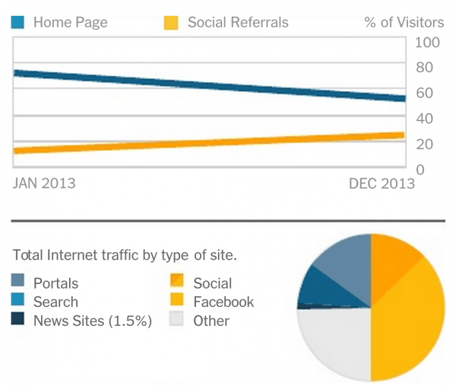
There was a time, not too long ago, when a company’s homepage was considered the most important page on their website. This is no longer the case.
Today, homepages are increasingly less important, because online behavior has changed. Users now arrive on company websites through various links they find via search engines, email links, social media, email, newsletters, remarketing, advertising, referrals, related websites, messages, and other channels.
As these entrance pathways generally direct users to landing pages, blog articles, and deeper website content containing specific topics, visitors are spending significantly less time on the homepage, and its importance and flow of traffic is declining steadily.
According to the leakedThe New York Times’ Innovation report, their homepage traffic has declined by almost 50% over a 2 year period. And, they are not alone.
The need is urgent. Our home page has been our main tool for getting our journalism to readers, but its impact is waning. -- NYTimes
 From the New York Times leaked innovation report.
From the New York Times leaked innovation report.
It’s not just The Times. The entire digital media industry is seeing a big shift in behavior. Reader visits to home pages are declining while traffic from social media is rising. (Source: BuzzFeed)
With that said, we aren’t recommending that companies remove the homepage from their websites entirely (or entirely ignore it). Although it’s less important, it still serves a vital purpose – which is to help users get to the next page, where they will access the information they need to convert and then move through the sales process.
Often times, homepages serve repeat visitors to a larger degree than first time visitors, because repeat visitors have a higher likelihood of directly "dialing" your website.
With all this in mind, here’s how to make sure your homepage fulfills its purpose of getting your visitors and key personas from Point A to Point B:
1. Embrace simplicity.
Most consumers define an ideal web experience as being able to find what they’re looking for quickly. To that end, avoid cluttering your homepage with excessive text, buttons, CTAs, images, and videos. Remove all the unnecessary distractions and focus on a simple design that clearly tells visitors 1. a simple story focusing on vision, impact or 2. provides guidance on taking deeper engagement or deeper relevance to their interests.
2. Focus on your personas.
The focus of your homepage should not be a parade of the products that your company offers, the services you provide, or how you are reliable and cost-effective your company may be. In addition, it’s not the place to share company news and your mission statement. In fact, your homepage isn’t the place to talk about you at all – it’s the place to talk about your customer or visitor! Frame the messaging so it embraces their needs and interests, and clearly communicates how your product or service will improve their lives or solve their problems.
3. End your dependency on sliders.
A slider is a design feature at the top of the home page that rotates every few seconds to showcase a different image and headline combination. They are very popular among designers and many companies have adopted them because it can solve political problems with communication real estate.
There’s only one problem: sliders don’t convert. Because they are time sensitive and change automatically, the visitor doesn’t get the opportunity to soak up the information on their own time, resulting in a frustrating user experience. Instead of using sliders on your home page, we recommend refining your message so you only need one headline and image combination. That way, users clearly understand your value, and are motivated to get to the next page where they will access more specific information catered to their unique needs.
4. Consider using dynamic website personalization.
Dynamic website personalization increases relevance, trust and engagement. If users encounter messaging and calls-to-action that directly relate to them, engagement will increase. A personalized website increases lead generation, online sales and outcomes by more closely mapping communications to your customers’ needs; building customer trust; and making it easier for buyers to make purchasing decisions.
62% of adults under 34 are willing to share their location for more relevant content. – NinthDecimal
74% of online consumers get frustrated when content (e.g. offers, ads, promotions) appears that has nothing to do with their interests. – Janrain & Harris Interactive
5. Story-telling is still important
Content is key, still. Organizations need to attract, inspire and spark the imaginations of it's audiences. The old methods of disruptive advertising, cold calling, spam and interruption simply do not work. Story-telling is vital. You have to earn attention--not buy it. This is also true of your organization's homepage. Story-telling needs to be central to how you engage users and direct them through their journey with your brand. Story-telling shapes the how, what and why of your messaging.
Learn more:
by Jonathan Franchell, CEO of Ironpaper - For more tips and hacks: Need to remove a new line after h1 tags? Both web designers and SEO practitioners need to employ headline tags: H1, H2, H3 in several ways to improve web page structure and tag...

The marketing industry is transforming significantly due to generative AI and increasing market complexity. Gartner's prediction of a 25% decline in traditional search traffic suggests that the era of search engines is dying. AI tools, particularly...

The Crowded Arena of the IT Marketplace Updated December 2024 The Information Technology (IT) landscape is experiencing rapid growth and intensifying competition. IT spending is projected to reach nearly 5.1 trillion U.S. dollars in 2024, a...

Updated December, 2024 The field of digital marketing is evolving rapidly in response to new technology and changing buyer expectations. To help career-minded marketers, we’ve rounded up the top 10 skills needed to succeed in the field. These are...
